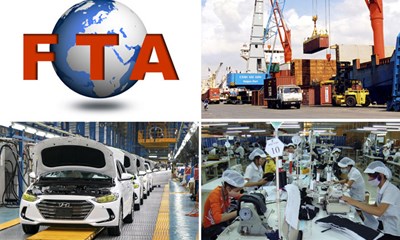VN-EAEU: Positive transformations after three years of implementing FTA
VGP – Since taking effect in 2016, the Free Trade Agreement between Viet Nam and the Eurasian Economic Union (VN-EAEU FTA) has contributed significantly to the strong growth of two-way trade between Viet Nam and EAEU countries compared to previously.
VN-EAEU: Positive transformations after three years of implementing FTA
Conspicuous effectiveness

Nikishina Veronika, minister of trade in the Eurasian Economic Commission (EEC), said that the two sides are optimistic about the positive results after three years of implementing the VN-EAEU FTA. This is reflected through the average annual growth rate of bilateral trade revenue. From only about 5% in the 2011-2015 period, the growth rate climbed to nearly 30% when the agreement came into effect in late 2016.
According to Viet Nam’s customs, trade turnover between Viet Nam and the EAEU reached US$4.9 billion in 2018, up 26.2% compared the previous year, of which Viet Nam exported US$2.7 billion and imported US$2.2billion worth of commodities. The two sides enjoyed a trade revenue of US$3.7 billion in the first nine months of 2019, and an estimated nearly US$5 billion for the whole, with Viet Nam exporting over US$3 billion to the EAEU market and importing approximately US$2 billion. In particular, Russia accounted for the largest proportion with 92%, followed by Kazakhstan (5.5%) and Belarus (2%).
Efforts made to facilitate trade
The two sides have endeavored to remove non-tariff barriers, including cooperation in electronizing administrative and customs procedures, while removing obstacles in the issue of certification of origin and negotiating on mutual recognition in the field of agriculture.
At the time of signing the VN-EAEU FTA, Viet Nam was the union’s first FTA partner, which meant that Vietnamese goods would have a special advantage to penetrate into the EAEU market. Since then, the EAEU has been actively integrating into the world economy through the negotiation of FTAs with many different partners. In Southeast Asia, Singapore became the second country, after Viet Nam, to sign an FTA with the EAEU, on October 1, 2019.
As committed in the VN-EAEU FTA, the two sides will open the market for about 90% of the total tariff lines, equivalent to over 90% of bilateral trade revenue. In addition, the two sides have committed to strengthen cooperation in many areas, such as trade remedies, rules of origin, customs management, technical barriers, measures concerning food hygiene and safety and animal and plant quarantine, government procurement, intellectual property, and sustainable development, in order to maximize trade between the two sides.
The EAEU is a fast growing economic region and a vast common market of five countries with a gross domestic product (GDP) of US$1.9 trillion and a population of 183 million people (in 2018).
Minister of Industry and Trade Tran Tuan Anh emphasized that, through the three-year implementation of the agreement, the two sides could consider the early negotiations on the goods items of their interest on the basis of balancing interests, thus creating conditions for the VN-EAEU FTA to generate high efficiency as expected.
By Vien Nhu

